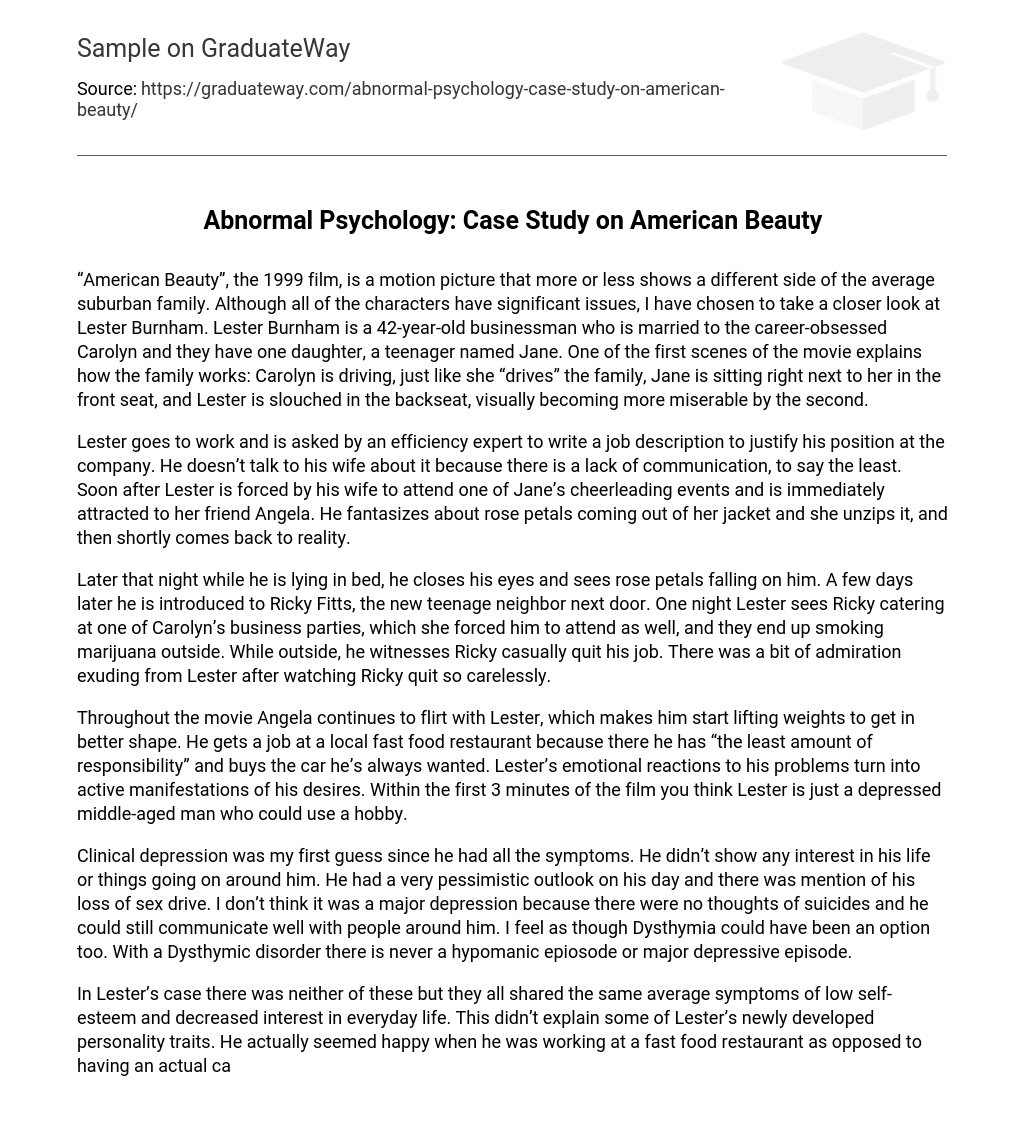“American Beauty”, the 1999 film, is a motion picture that more or less shows a different side of the average suburban family. Although all of the characters have significant issues, I have chosen to take a closer look at Lester Burnham. Lester Burnham is a 42-year-old businessman who is married to the career-obsessed Carolyn and they have one daughter, a teenager named Jane. One of the first scenes of the movie explains how the family works: Carolyn is driving, just like she “drives” the family, Jane is sitting right next to her in the front seat, and Lester is slouched in the backseat, visually becoming more miserable by the second.
Lester goes to work and is asked by an efficiency expert to write a job description to justify his position at the company. He doesn’t talk to his wife about it because there is a lack of communication, to say the least. Soon after Lester is forced by his wife to attend one of Jane’s cheerleading events and is immediately attracted to her friend Angela. He fantasizes about rose petals coming out of her jacket and she unzips it, and then shortly comes back to reality.
Later that night while he is lying in bed, he closes his eyes and sees rose petals falling on him. A few days later he is introduced to Ricky Fitts, the new teenage neighbor next door. One night Lester sees Ricky catering at one of Carolyn’s business parties, which she forced him to attend as well, and they end up smoking marijuana outside. While outside, he witnesses Ricky casually quit his job. There was a bit of admiration exuding from Lester after watching Ricky quit so carelessly.
Throughout the movie Angela continues to flirt with Lester, which makes him start lifting weights to get in better shape. He gets a job at a local fast food restaurant because there he has “the least amount of responsibility” and buys the car he’s always wanted. Lester’s emotional reactions to his problems turn into active manifestations of his desires. Within the first 3 minutes of the film you think Lester is just a depressed middle-aged man who could use a hobby.
Clinical depression was my first guess since he had all the symptoms. He didn’t show any interest in his life or things going on around him. He had a very pessimistic outlook on his day and there was mention of his loss of sex drive. I don’t think it was a major depression because there were no thoughts of suicides and he could still communicate well with people around him. I feel as though Dysthymia could have been an option too. With a Dysthymic disorder there is never a hypomanic epiosode or major depressive episode.
In Lester’s case there was neither of these but they all shared the same average symptoms of low self-esteem and decreased interest in everyday life. This didn’t explain some of Lester’s newly developed personality traits. He actually seemed happy when he was working at a fast food restaurant as opposed to having an actual career. I also started to think about the fact that he was smoking marijuana on a daily basis now, which is substance abuse. It definitely caused a shift in attitude and changed his personality. Acute stress disorder was another thought. Acute stress disorder is characterized by the development of severe anxiety, dissociative, and other symptoms that occur within one month after exposure to an extreme traumatic stressor” (Psych Central, 2009). At first I considered Lester losing his job as an extreme stressor but in order for him to have this disorder, the stressor and the symptoms would have to be a lot more severe. The dissociative tendencies that Lester showed made me think Acute Stress Disorder could be an option.
He started identifying with activities and personality traits that weren’t his own. Lifting weights, smoking marijuana, driving his dream car, and simply being careless. All of these were traits that weren’t depicted in the Lester we met at the beginning of the movie. 3 I feel as though Lester Burnham has an Adjustment disorder. Adjustment disorders are defined as “an emotional or behavioral reaction to an identifiable stressful event or change in a person’s life that is considered maladaptive or somehow not an expected healthy response (United Behavioral Health, 2004). This disorder is pretty common; symptoms usually begin within three months of the stressors and last no longer than six months.
Behavioral symptoms, which Lester established, incorporate: withdrawal, decrease in work performance, reckless behavior, acting out, and relationship problems (PsychNet-UK). These are a characteristic of those witnessed in adolescents diagnosed with adjustment disorder, although we see Lester identify with adolescents so much through his thoughts and actions that it seems appropriate.
The specification “disturbance of conduct” refers to the violation of societal norms which for Lester includes nearly every act he took in reaction to his stress: lusting after the underage Angela and later nearly having sex with her, buying drugs, and blackmailing his company. Since a time frame within which the story takes place is not specified-except for Lester mentioning in the introduction that he will die in less than a year-the ability to diagnose his disorder as acute or chronic is rather dubious. Acute adjustment disorder lasts less than six months while chronic adjustment disorder may last six months or longer (PsychNet-UK, n. . ). It would be tempting to say Lester had a midlife crisis and leave him undiagnosed. For two reasons this is incorrect.
First, the notion of a midlife crisis as its own mental disorder is unfounded. Secondly, a midlife crisis is defined as a “personal turmoil and coping challenges brought on by fears and anxieties about growing older”; more than twenty-five percent of Americans think they have had a midlife crisis, (Lang, 2001). Had Lester not been murdered, therapy would be the most effective treatment.





